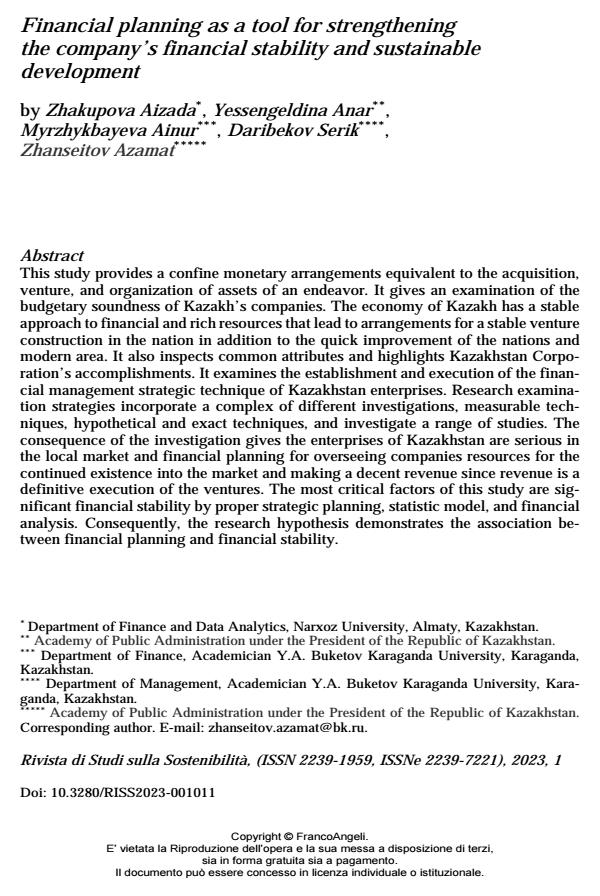Financial planning as a tool for strengthening the company’s financial stability and sustainable development
Titolo Rivista RIVISTA DI STUDI SULLA SOSTENIBILITA'
Autori/Curatori Zhakupova Aizada, Yessengeldina Anar, Myrzhykbayeva Ainur, Daribekov Serik, Zhanseitov Azamat
Anno di pubblicazione 2023 Fascicolo 2023/1
Lingua Inglese Numero pagine 16 P. 187-202 Dimensione file 136 KB
DOI 10.3280/RISS2023-001011
Il DOI è il codice a barre della proprietà intellettuale: per saperne di più
clicca qui
Qui sotto puoi vedere in anteprima la prima pagina di questo articolo.
Se questo articolo ti interessa, lo puoi acquistare (e scaricare in formato pdf) seguendo le facili indicazioni per acquistare il download credit. Acquista Download Credits per scaricare questo Articolo in formato PDF

FrancoAngeli è membro della Publishers International Linking Association, Inc (PILA)associazione indipendente e non profit per facilitare (attraverso i servizi tecnologici implementati da CrossRef.org) l’accesso degli studiosi ai contenuti digitali nelle pubblicazioni professionali e scientifiche
This study provides a confine monetary arrangements equivalent to the acquisi-tion, venture, and organization of assets of an endeavor. It gives an examination of the budgetary soundness of Kazakh’s companies. The economy of Kazakh has a stable approach to financial and rich resources that lead to arrangements for a stable venture construction in the nation in addition to the quick improvement of the nations and modern area. It also inspects common attributes and highlights Kazakhstan Corporation’s accomplishments. It examines the establishment and execution of the financial management strategic technique of Kazakhstan enter-prises. Research examination strategies incorporate a complex of different investi-gations, measurable techniques, hypothetical and exact techniques, and investi-gate a range of studies. The consequence of the investigation gives the enterprises of Kazakhstan are serious in the local market and financial planning for oversee-ing companies resources for the continued existence into the market and making a decent revenue since revenue is a definitive execution of the ventures. The most critical factors of this study are significant financial stability by proper strategic planning, statistic model, and financial analysis. Consequently, the research hy-pothesis demonstrates the association between financial planning and financial stability.
Parole chiave:financial stability, financial strategy, sustainability, market, investors, profit, GDP.
- Ahrens J. and Stark M. (2014). Emulating Developmental States? The Institutional Foundations of Economic Transition in Kazakhstan. Critique internationale, 63(2): 95-110.
- Bhuiyan S.H. and Amagoh F. (2011). Public sector reform in Kazakhstan: issues and perspectives. International Journal of Public Sector Management, 24 (3): 227-249.
- Boiko I. (2013). Instruments of Implementing the Enterprises Strategy. Economics & Sociology, 6(2).
- Duplij E.V. (2016). Dividend payments and cross-country differences in the choice of dividend. International Journal of Economics and Financial Issues, 6(1S): 46-51.
- Grinblatt M. and Titman S. (2000). Financial Analysis and Corporate Strategy. The Review of Financial Studies, 13(1): 249-253.
- Istaitieh A. and Rodríguez J. (2003). Financial Leverage Interaction with Firm’s Strategic Behavior: An Empirical Analysis. EFMA Helsinki Meetings, 40.
- Jacobi G. (1992). Financial Tools for Competitive Analysis. Competitive Intelligence Review, 3(2): 14-18.
- Kurbanova K. and Mukhametzhanova Z. & Saparbayev A. & Supugalieva G. (2020). Analysis of the financial stability of the Kazakhstan’s economy.
- Maua V. and Ulyukaevb A. (2015). Global Crisis and Challenges for Russian Economic Development. Russian Journal of Economics, 1(1): 4-29.
- Mendelson A. and Pedersen L. (2006). Liquidity and Asset Prices. Foundations and Trends in Finance, 1(4): 269-364.
- Pagano M. (1989). Trading Volume and Asset Liquidity. The Quarterly Journal of Economics, 104(2): 255-274
- Payne K. and Foster J. (2017). Russian Strategy: Expansion, Crisis and Conflict. Comparative Strategy, 36(1): 1-89.
- Rajan R. and Zingales L. (1998). Financial Dependence and Growth. American Economic Review, 88(3): 559-86.
- Sarsengalieva K. (2015). Economics, management, finance: materials of the V Intern. scientific conf., 63-66.
- Simachev Y., Kuzyk M., Kuznetsov B. and Pogrebnyak E. (2014). Russia on the Path Towards a New Technology Industrial Policy: Exciting Prospects and Fatal Traps. Foresight and STI Governance, 8(4): 6-23.
- Simon W. (2001). Asset liquidity, Capital Structure,and Secured Debt. Journal of Financial Economics, 61(2): 173-206.
- Yerdavletova F., Ermekbaeva B., Zhunissova G. and Mukhametzhanova Z. (2020). Overview of actions to strengthen financial stability of companies.
- Zumanova B.K., Doskeyeva G., Nukesheva A., Sarkhanov K.A., Sundetov Z.S., Kurmankulova N.Z. and Danishev A.B. (2016). Management strategy for the resources of financial corporations in the republic of Kazakhstan. International Journal of Economic Perspectives.
Zhakupova Aizada, Yessengeldina Anar, Myrzhykbayeva Ainur, Daribekov Serik, Zhanseitov Azamat, Financial planning as a tool for strengthening the company’s financial stability and sustainable development in "RIVISTA DI STUDI SULLA SOSTENIBILITA'" 1/2023, pp 187-202, DOI: 10.3280/RISS2023-001011